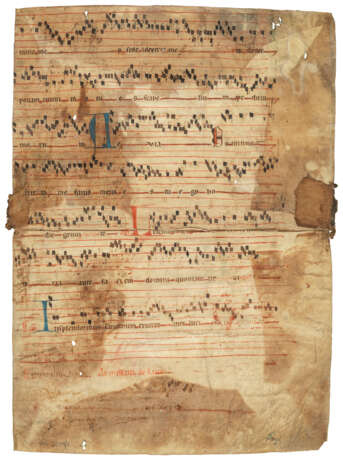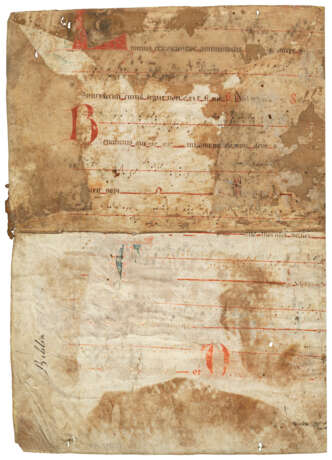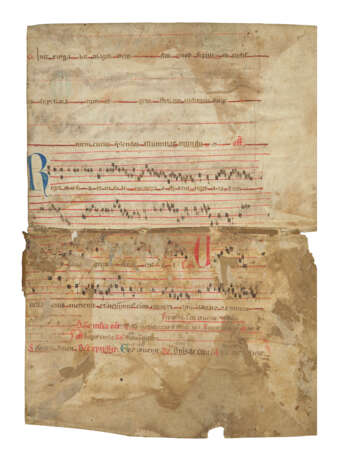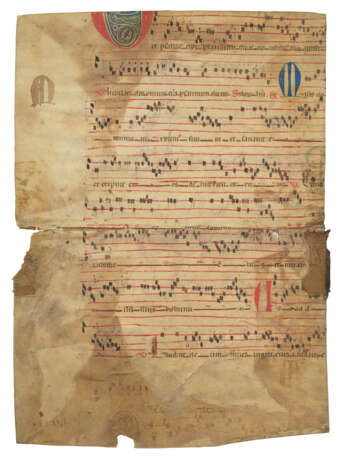ID 1053123
Lot 9 | Aquitanian neumes
Estimate value
£ 1 500 – 2 000
Two leaves from a Gradual, palimpsest, in Latin, manuscript on vellum [France, the underlying text 11th century, the overlying text 14th century]
A rare example of earlier notation being updated: in this case 11th-century Aquitanian notation with 14th-century square notation.
c.330 x 240mm, 2 leaves, underlying text and music: 8 lines written in brown ink in a rounded late Carolingian script, alternating red and blue initials, Aquitanian notation with no clefs but a single red line to show the pitch F, lines ruled above and below with a dry point for adjacent pitches; overlying music: square notation on staves of between four and five lines ruled in red (recovered from a binding and consequently with stains, horizontal crease across the middle and some overall wear, a few holes, cropped at top and outer edges, outer margin torn with small losses). Bound in grey buckram by Celia Alberman in 2005.
Provenance:
(1) Sotheby’s, 5 July 2005, part of lot 2.
(2) Schøyen Collection, MS 5284/1.
Text:
The text contains the Masses for the Feast of the Nativity (verso of the first leaf), from 'Lux fulgebit hodie super nos' to 'In splendoribus sanctorum ex utero ante luciferum genui te. Seculorum Amen. Ad missam de luce' (recto of the first leaf); and Epiphany, from 'O[mnis terra adoret te deus] et psallat tibi psalmum dicat nomini tuo' to 'Vidimus stellam eius in oriente et venimus cum muneribus adorare dominum'.
Script and music:
This fragment of a palimpsest was originally written in the 11th century with Aquitanian notation, in widespread use in the south of France, with, from its very inception, the neumes organised according to pitch above and below an imaginary line. The earlier text was erased and replaced with the same chants for the night Mass of Christmas Eve, written in a square notation of the 14th century on staves of between four and five lines ruled in red. This provides a relatively rare example of a notation being updated, perhaps because the earlier text had become worn to the point of illegibility, or perhaps to provide a more familiar and easily legible version of the chants already notated on the page. The verso of the first leaf as presented here was erased but no new music was added.
| Place of origin: | France |
|---|---|
| Auction house category: | Medieval & renaissance manuscripts |
| Place of origin: | France |
|---|---|
| Auction house category: | Medieval & renaissance manuscripts |
| Address of auction |
CHRISTIE'S 8 King Street, St. James's SW1Y 6QT London United Kingdom | ||||||
|---|---|---|---|---|---|---|---|
| Preview |
| ||||||
| Phone | +44 (0)20 7839 9060 | ||||||
| Buyer Premium | see on Website | ||||||
| Conditions of purchase | Conditions of purchase |






